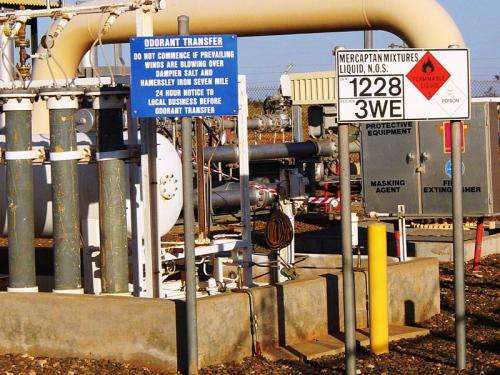A potentially cheap, efficient and eco-friendly system for purifying natural gas

Fundamental researchers at the Colorado School of Mines have proposed a novel two-part system for separating impurities from natural gas in the Journal of Renewable and Sustainable Energy. Natural gas primarily contains methane, but impurities in the gaseous mixture need to be removed before the methane can be put into the pipeline. The newly proposed purification system combines two separation methods and, in principle, promises to improve performance, reduce costs and diminish ecological side effects compared to benchmark technologies.
Natural gas processing typically relies on high-temperature techniques that incur high operating costs. "We propose an integrated process consisting of gas hydrates and membranes, to make the overall process of purifying natural gas potentially more economical without high-temperature driven processes," said co-author Moises Carreon, an expert in membrane separating technologies.
Membrane technology applies different types of material to filter out carbon dioxide and nitrogen from raw natural gas. Propane and hydrogen sulfide are also often present and can negatively affect membrane performance. A possible solution to this problem emerged when Carolyn Koh, an expert in hydrates, Pramod Warrier, postdoctoral researcher, and Carreon began talking.
"Hydrates form hydrogen-bonded water cages that trap the gases you want to separate," Koh said. "It's a potentially very selective way of trapping those gases." Different pressure and temperature conditions are required for impurity hydrates to form compared to methane hydrates. The engineers decided to introduce selective hydrate formation as a preliminary step to the membrane separation process.
In the paper, the researchers used well-established algorithms to prove the feasibility of specific hydrates' formation. These conditions have a relatively low energy demand that could make the integrated system economical.
"In this integrated system, we first remove all of the nasty chemicals present in natural gas using gas hydrates to produce a purer mixture," Cameron said. He then explained how the purer mixture of gases is easier to separate using membrane technology.
Hydrate formation is not only energy-efficient but also environmentally friendly. Water is the only additional material required for gas hydrate formation, and it effectively sequesters hazardous gases like hydrogen sulfide into the solid hydrate form, which prevents its release into the environment. There are some other contaminants that need to be removed separately, but this newly proposed system reduces environmental impact from the current industrial processes.
The integrated hydrate-membrane system can also serve as a model for other molecular gas separations, such as hydrogen gas purification.
The engineers are now focused on proving their theoretical concept. "We're trying to demonstrate that this integrated system can effectively separate natural gas impurities in laboratory experiments," said Carreon. Part of that work will involve optimization to ensure that the hydrate structures form easily and rapidly, and can maintain their stability.
More information: Pramod Warrier et al, Integrated gas hydrate-membrane system for natural gas purification, Journal of Renewable and Sustainable Energy (2018). DOI: 10.1063/1.5019967
Journal information: Journal of Renewable and Sustainable Energy
Provided by American Institute of Physics




















